Porcelain and glass
Before 1941, the Gatchina museum’s holdings of decorative arts included a unique porcelain and glass collection dating from the 16th to the early 20th centuries. The most important pieces in the collection were the artworks produced at the Imperial Porcelain Factory in St. Petersburg and by leading European manufactures, as well as an extensive range of porcelain ware from China and Japan.
The collection was considerably damaged during World War II. Nevertheless, over 2,300 pieces have been preserved that now make up the core of the Gatchina palace’s porcelain and glass collection, comprising fine Russian pieces of art, works produced by masters from Meissen, Vienna and Berlin porcelain manufactories and Sevres masterpieces.
The collection was considerably damaged during World War II. Nevertheless, over 2,300 pieces have been preserved that now make up the core of the Gatchina palace’s porcelain and glass collection, comprising fine Russian pieces of art, works produced by masters from Meissen, Vienna and Berlin porcelain manufactories and Sevres masterpieces.
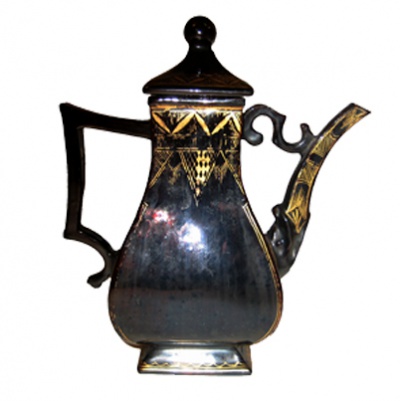 Coffeepot
Coffeepot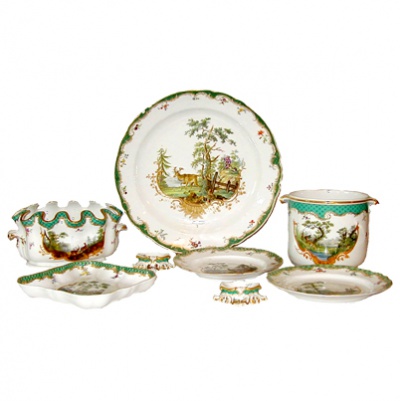 The Hunting Dinner set
The Hunting Dinner set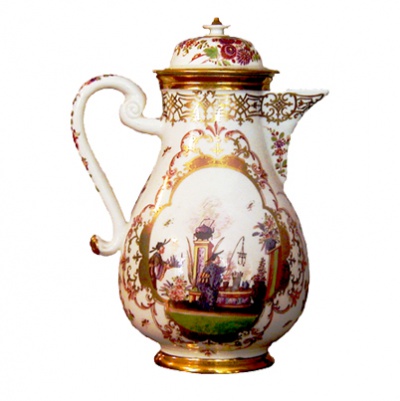 Coffeepot
Coffeepot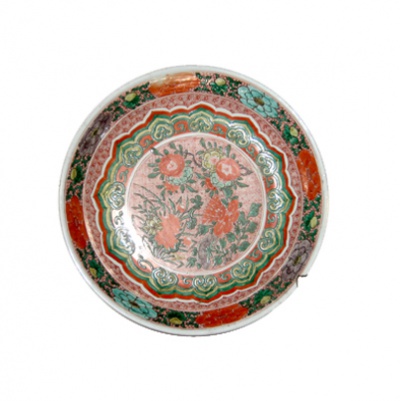 Dish
Dish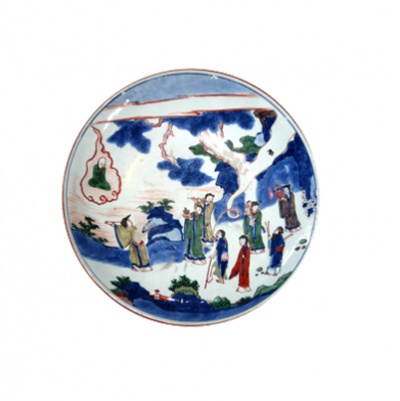 Dishes
Dishes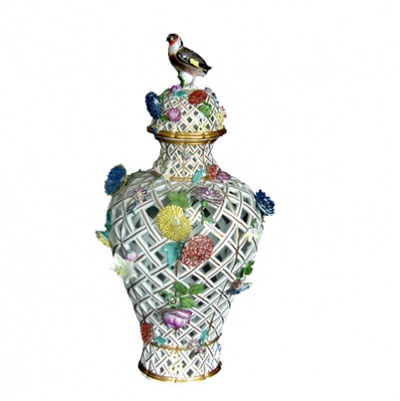 Vase
Vase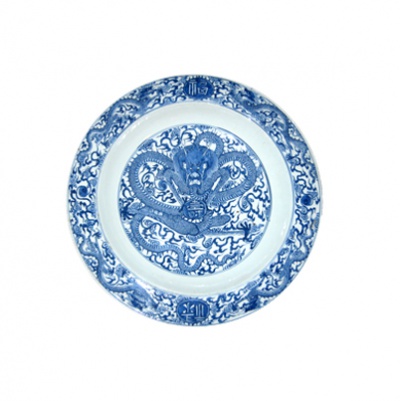 Dish
Dish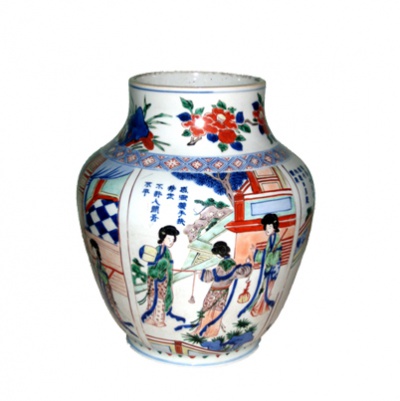 Vase
Vase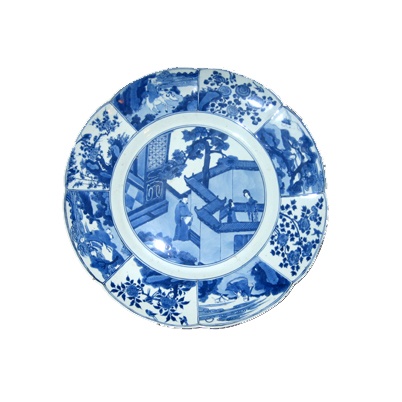 Dish
Dish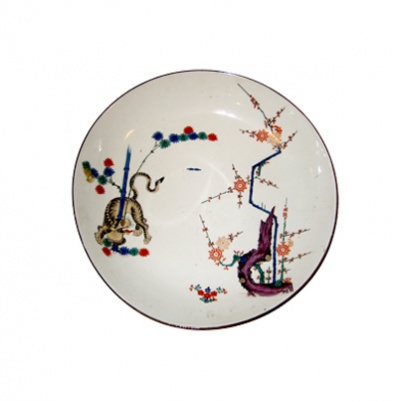 Dish
Dish
Coffeepot
Saxony, Meissen Royal Manufactory, ca. 1710
Porcelain decorated with black glaze, luster, and gilt; height: 21 cm. ГДМ-550-I
The present coffeepot is the earliest item in the Gatchina collection, produced at the Meissen Manufactory in the time of Johann Friedrich Böttger, the renowned inventor of European porcelain. The coffeepot was part of the Chinese Gallery interior decoration and is now displayed in themed exhibitions.
Saxony, Meissen Royal Manufactory, ca. 1710
Porcelain decorated with black glaze, luster, and gilt; height: 21 cm. ГДМ-550-I
The present coffeepot is the earliest item in the Gatchina collection, produced at the Meissen Manufactory in the time of Johann Friedrich Böttger, the renowned inventor of European porcelain. The coffeepot was part of the Chinese Gallery interior decoration and is now displayed in themed exhibitions.
The Hunting Dinner set
Saxony, Meissen Royal Manufactory, 1766-68
Russia, Imperial Porcelain Factory, second half 18th-19th c.
The Hunting Dinner set is the landmark of the Gatchina Palace. Commissioned from the renowned Meissen manufactory by the Imperial House, it was the most extensive dinner set produced in the 18th century. This legendary porcelain ensemble was considerably extended at the Imperial Porcelain Manufactory in St Petersburg, and numbered 200 items in the 19th century. The Gatchina collection now includes 335 items from the set, the largest collection kept in any of the world’s museums.
Saxony, Meissen Royal Manufactory, 1766-68
Russia, Imperial Porcelain Factory, second half 18th-19th c.
The Hunting Dinner set is the landmark of the Gatchina Palace. Commissioned from the renowned Meissen manufactory by the Imperial House, it was the most extensive dinner set produced in the 18th century. This legendary porcelain ensemble was considerably extended at the Imperial Porcelain Manufactory in St Petersburg, and numbered 200 items in the 19th century. The Gatchina collection now includes 335 items from the set, the largest collection kept in any of the world’s museums.
Coffeepot
Saxony, Meissen Royal Manufactory, ca. 1725-1735
Porcelain with overglaze polychrome decoration, luster, gilding, and relief; height: 21 cm.
ГДМ-550-I
The Gatchina holdings include a selection of rare and early Meissen porcelain. The coffeepot is from the private collection of Alexander Feodorovna, Nickolas I’s spouse. Considering their high artistic value, similar artworks were meant for display only and not for daily use. The coffeepot is displayed in exhibitions related to the porcelain collection at the Gatchina Palace.
Saxony, Meissen Royal Manufactory, ca. 1725-1735
Porcelain with overglaze polychrome decoration, luster, gilding, and relief; height: 21 cm.
ГДМ-550-I
The Gatchina holdings include a selection of rare and early Meissen porcelain. The coffeepot is from the private collection of Alexander Feodorovna, Nickolas I’s spouse. Considering their high artistic value, similar artworks were meant for display only and not for daily use. The coffeepot is displayed in exhibitions related to the porcelain collection at the Gatchina Palace.
Dish
China, 1644-1662
Porcelain with polychrome decoration; diameter: 36, 33 сm. ГДМ-357-I, ГДМ-362-I
Decorative art objects of such artistic value/standard are exceptionally rare in both Russian and foreign porcelain collections. These dishes formerly adorned the Chinese Gallery and are now displayed in themed exhibitions.
China, 1644-1662
Porcelain with polychrome decoration; diameter: 36, 33 сm. ГДМ-357-I, ГДМ-362-I
Decorative art objects of such artistic value/standard are exceptionally rare in both Russian and foreign porcelain collections. These dishes formerly adorned the Chinese Gallery and are now displayed in themed exhibitions.
Dishes
China, 1644-1662
Porcelain with polychrome decoration; diameter: 36, 33 сm. ГДМ-357-I, ГДМ-362-I
Decorative art objects of such artistic value/standard are exceptionally rare in both Russian and foreign porcelain collections. These dishes formerly adorned the Chinese Gallery and are now displayed in themed exhibitions.
China, 1644-1662
Porcelain with polychrome decoration; diameter: 36, 33 сm. ГДМ-357-I, ГДМ-362-I
Decorative art objects of such artistic value/standard are exceptionally rare in both Russian and foreign porcelain collections. These dishes formerly adorned the Chinese Gallery and are now displayed in themed exhibitions.
Vase
Saxony, Meissen Royal Manufactory, second half of the 18th c.
Porcelain with overglaze polychrome painting, openwork decoration in relief; height: 55 cm. ГДМ-221-I
This vase comes from the collection of Empress Maria Feodorovna, Alexander II’s wife. It was part of Empress’s study’s decorations. A rare decorative object of high artistic value, it is now displayed in the exhibition that focus on the porcelain collection at the Gatchina Palace.
Saxony, Meissen Royal Manufactory, second half of the 18th c.
Porcelain with overglaze polychrome painting, openwork decoration in relief; height: 55 cm. ГДМ-221-I
This vase comes from the collection of Empress Maria Feodorovna, Alexander II’s wife. It was part of Empress’s study’s decorations. A rare decorative object of high artistic value, it is now displayed in the exhibition that focus on the porcelain collection at the Gatchina Palace.
Dish
China, 1662-1722
Porcelain painted in cobalt; diameter: 52 cm. ГДМ-196-I
This rare dish decorated with a dragon (emperor’s symbol in China) and inscribed with the motto of the ruling Chinese emperor forms part of a presentation gifts given to the Russian Imperial House. The dish adorned the famous Chinese Gallery at the Gatchina Palace and is now displayed in themed exhibitions.
China, 1662-1722
Porcelain painted in cobalt; diameter: 52 cm. ГДМ-196-I
This rare dish decorated with a dragon (emperor’s symbol in China) and inscribed with the motto of the ruling Chinese emperor forms part of a presentation gifts given to the Russian Imperial House. The dish adorned the famous Chinese Gallery at the Gatchina Palace and is now displayed in themed exhibitions.
Vase
China, 1644-1662
Porcelain painted in cobalt, overglaze polychrome decoration; height: 29 cm. ГДМ-265-I
This is one of a pair of vases, and the other matches in shape and design (ГДМ-266-I). Both pieces are among the rarities of the renowned collection of decorative arts from the Far East at the Gatchina Palace. The vases decorated the Chinese gallery until 1941 and are now displayed in themed exhibitions.
China, 1644-1662
Porcelain painted in cobalt, overglaze polychrome decoration; height: 29 cm. ГДМ-265-I
This is one of a pair of vases, and the other matches in shape and design (ГДМ-266-I). Both pieces are among the rarities of the renowned collection of decorative arts from the Far East at the Gatchina Palace. The vases decorated the Chinese gallery until 1941 and are now displayed in themed exhibitions.
Dish
China, 1644-1662
Porcelain painted in cobalt; diameter: 51.5 cm. ГДМ-208-I
This dish is decorated with motifs that symbolize a long, happy marriage, and which are skilfully executed to demonstrate the best examples of Chinese calligraphy. It was probably a wedding gift to the members of imperial family. The dish comes from the interior decorations of the Chinese Gallery and is now displayed in themed exhibitions.
China, 1644-1662
Porcelain painted in cobalt; diameter: 51.5 cm. ГДМ-208-I
This dish is decorated with motifs that symbolize a long, happy marriage, and which are skilfully executed to demonstrate the best examples of Chinese calligraphy. It was probably a wedding gift to the members of imperial family. The dish comes from the interior decorations of the Chinese Gallery and is now displayed in themed exhibitions.
Dish
Saxony, Meissen Royal Manufactory, 1729-1730
Porcelain with polychrome and gilt decoration, painted overglaze; diameter: 45 cm. ГДМ-220-I
This dish comes from the renowned dinner sets “The Yellow Lion,” which claimed to be the first dinner sets produced in Saxony. The exceptional provenance of the item is further enhanced by its inventory number from the Japanese Palace of Augustus the Strong, Elector of Saxony, who actually made the invention of European porcelain possible. Until 1941, the dish adorned the Chinese Gallery, which along with decorative arts from the Far East also featured porcelain in the so-called chinoiserie style, as it was known outside of Russia. The dish is currently displayed in themed exhibitions.
Saxony, Meissen Royal Manufactory, 1729-1730
Porcelain with polychrome and gilt decoration, painted overglaze; diameter: 45 cm. ГДМ-220-I
This dish comes from the renowned dinner sets “The Yellow Lion,” which claimed to be the first dinner sets produced in Saxony. The exceptional provenance of the item is further enhanced by its inventory number from the Japanese Palace of Augustus the Strong, Elector of Saxony, who actually made the invention of European porcelain possible. Until 1941, the dish adorned the Chinese Gallery, which along with decorative arts from the Far East also featured porcelain in the so-called chinoiserie style, as it was known outside of Russia. The dish is currently displayed in themed exhibitions.
